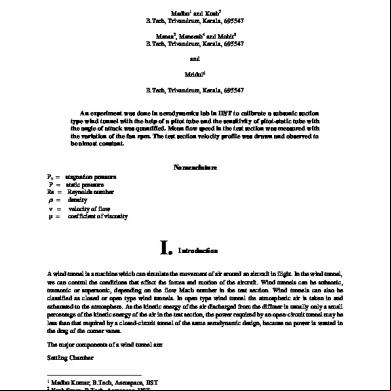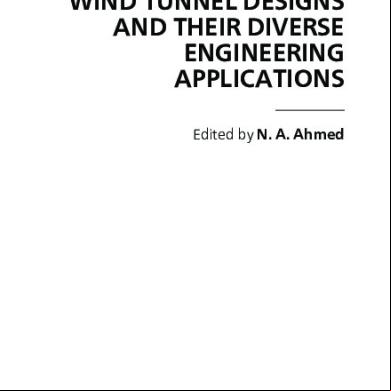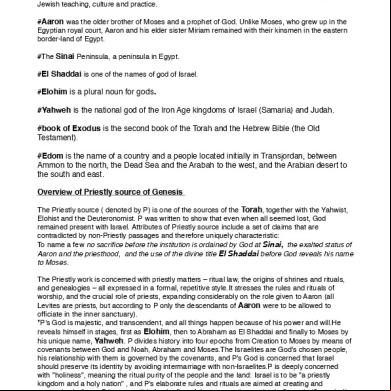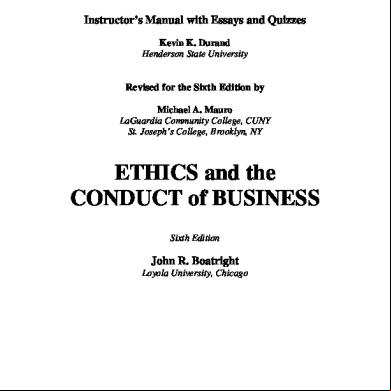Calibration Of A Wind Tunnel 112s4z
This document was ed by and they confirmed that they have the permission to share it. If you are author or own the copyright of this book, please report to us by using this report form. Report 2z6p3t
Overview 5o1f4z
& View Calibration Of A Wind Tunnel as PDF for free.
More details 6z3438
- Words: 2,881
- Pages: 12
Calibration of wind tunnel and sensitivity of a pitot-static tube with angle of attack Madhu1 and Kush2 B.Tech, Trivandrum, Kerala, 695547 Manas3, Maneesh4 and Mohit5 B.Tech, Trivandrum, Kerala, 695547 and Mridul6 B.Tech, Trivandrum, Kerala, 695547
An experiment was done in aerodynamics lab in IIST to calibrate a subsonic suction type wind tunnel with the help of a pitot tube and the sensitivity of pitot-static tube with the angle of attack was quantified. Mean flow speed in the test section was measured with the variation of the fan rpm. The test section velocity profile was drawn and observed to be almost constant.
Nomenclature Po = stagnation pressure P = static pressure Re = Reynolds number = density v = velocity of flow µ = coefficient of viscosity
I.
Introduction
A wind tunnel is a machine which can simulate the movement of air around an aircraft in flight. In the wind tunnel, we can control the conditions that effect the forces and motion of the aircraft. Wind tunnels can be subsonic, transonic or supersonic, depending on the flow Mach number in the test section. Wind tunnels can also be classified as closed or open type wind tunnels. In open type wind tunnel the atmospheric air is taken in and exhausted to the atmosphere. As the kinetic energy of the air discharged from the diff is usually only a small percentage of the kinetic energy of the air in the test section, the power required by an open-circuit tunnel may be less than that required by a closed-circuit tunnel of the same aerodynamic design, because no power is wasted in the drag of the corner vanes. The major components of a wind tunnel are: Settling Chamber
1
Madhu Kumar, B.Tech, Aerospace, IIST Kush Sreen, B.Tech, Aerospace, IIST 3 Manas Maraal, B.Tech, Aerospace, IIST 4 Maneesh Kumar, B.Tech, Aerospace, IIST 5 Mohit Singh Malik, B.Tech, Aerospace, IIST 6 Mridul Songara, B.Tech, Aerospace, IIST 2
1
The primary function of the settling chamber is to make the air flow unidirectional and uniform as it enters the wind tunnel and es to the next section. A honeycomb-shaped structure and wire mesh screens remove turbulence and reduces the speed of air to approximately zero, so that for theoretical purpose pressure P measured in this chamber is taken to be stagnation pressure P o. The settling chamber reduces fluctuations in velocity.
Contraction Cone
The function of contraction cone is to increase the velocity of flow with decrease in static pressure i.e. to convert pressure energy of flow to its kinetic energy. It is basically used to accelerate the flow, which is usually done with a fan which consumes more power for same flow speed to be obtained in the test section.
Test Section
The test section houses the test object, along with sensors that measure its response to wind forces. One force measured in the test section is lift, which causes objects to rise. Another is drag, which is a measure of an object's resistance to air as it moves through the atmosphere.
Diff
The diff slows the high velocity of air in the wind tunnel before it exits the system and increases the static pressure P. The recovery of pressure from kinetic energy reduces the power needed to drive the tunnel.
Drive Section
The drive section is responsible for pulling air through the entire tunnel. Normally, large exhaust fans draw air through the tunnel.
To ascertain that results obtained from the wind tunnel testing are applicable to real-life situations, dynamic similarity has to be satisfied. The criteria to ensure that two flows are dynamic similar is as follows:
Bodies and any other boundaries are geometrically similar for both flows. Similarity parameters (usually Re, M and 𝛼 for given body) are same for both flows.
2
Pitot-Static tubes, which are also called Prandtl tubes, are used on aircraft as speedometers. Several small holes are drilled around the outside of the tube and a centre hole is drilled down the axis of the tube. Both the centre hole and outside hole are connected to a manometer, which gives the difference in static and stagnation P (dynamic P) as difference in levels of the manometric fluid.
II. Theory The experiment was done on a typical suction type wind tunnel with maximum speed capacity of 40m/s.A Pitot tube measures both static and stagnation pressures and can be used to measure the speed of the flow in the test section. Using Bernoulli's equation: Stagnation pressure = static pressure + dynamic pressure, which can also be written 𝑝𝑜 = 𝑝𝑠 +
1 2
𝜌𝑣 2
Solving for the velocity we get 𝑣=√
2 ∗ (𝑝𝑜 − 𝑝𝑠 ) 𝜌
Where: • 𝑣 is fluid velocity • 𝑝𝑜 is stagnation pressure • 𝑝𝑠 is stagnation pressure • 𝜌 is fluid density The Bernoulli’s equation is applicable only for incompressible, inviscid and steady flows, which is true in our case since the maximum velocity achievable in the wind tunnel is 40 m/s, which is smaller than Mach 0.3 and flow through the settling chamber is uniform and unidirectional and effects of viscosity is neglected.
III. Experimental setup The experiment was done on a typical suction type wind tunnel with speed maximum speed capacity of 40m/s in aerodynamic lab at IIST. The set up mainly consists of an axial flow fan, converging duct, 300 x 400 x 600 test section. The bell mouth section is fitted with honeycomb mesh to reduce the turbulence and impurities with incoming air. The fan was driven by a three phase motor with 5 HP power capacities. Multi-tube manometer with variable inclination is used to measure the pressure at various cross section of the wind tunnel. The manometric fluid used is ethyl alcohol in order to measure even small changes in pressure. The test section houses two Pitot - static tubes in order to measure the static and total P at different locations and different orientations in the test section.
3
IV. Procedure The Pitot tube is placed in the centre of the test section and reading is measured from multitube manometer for varying fan rpm. These readings are used to calibrate the wind tunnel. To measure the variation of velocity across the cross section of the test section, the manometer reading is measured for different heights of the Pitot tube. Using these readings we get velocity distribution (transverse section) in the test section. Another Pitot tube is placed near the wall of the test section, so that its inclination can be varied. For variation of inclination from -30o to 30o manometer readings are noted. These readings can be used to quantify the sensitivity of the Pitot tube with angle of attack. The Pitot tube is rotated by 90o along its own axis and again, for various inclinations, manometer readings are noted, so that effect of orientation of the pitot static tube can be observed.
V. Sample Calculation Calibration of subsonic wind tunnel: For reading #4 @ 800 rpm
Initial level of manometer
= 8.7 cm
Density of ethanol (ρ e)
= 789 kg/m3
Density of air (ρ∞)
= 1.16 kg/m 3
Level of manometer corresponding total P in Pitot - static (h5) = 9.1 cm Level of manometer corresponding P in Pitot - static (h4)
= 11.0 cm
Level of manometer corresponding total P in settling chamber (h30) = 9.2 cm Level of manometer corresponding P at the inlet of test section (h30) = 11.1 cm
Total P in Pitot - static tube (Po2) = P atm + ρ eg (0.087-h5)/√2
= P atm + ρ e g (0.087-0.091)/ √2
Static P in Pitot - static tube (P) = P atm + ρ e g (0.087-h4)/ √2
= P atm + ρ e g (0.087-0.11)/ √2 Po2 - P = ρ e g (0.11-0.091)/ √2
=789*9.81*0.019/√2 =104.00 N/m2 Assuming flow to be incompressible and isentropic, Po2 – P = 0.5* ρ ava2 2∗(Po2 – P)
va = √
va = √
ρa
√2 ∗ (147.06) 1.167
4
va = 13.35 m/s Re =
𝜌𝑎 𝑣 𝑎 𝑑 𝜇
For unit Re, d=1m Unit Re =
𝜌𝑎 𝑣 𝑎
=
𝜇 1.167∗15.87 1.983∗10−5
= 933953.10136 m-1
Using continuity equation, Ats va = A30v30 Ats = Cross-sectional area of the test section A30 = Cross-sectional area of the settling chamber v30 = velocity of air in the settling chamber. v30 =
𝐴𝑡𝑠 𝐴30
𝑣𝑎
From specifications, v30 =
𝐴𝑡𝑠 𝐴30
= 1:6
1∗13.35 6
v30 = 2.225 m/s Pressure loss in the section from inlet to wire mesh = P atm - Ps30 = P atm - (P30 + 0.5* ρ av302) = P atm – (P atm + ρ e g (0.087-h30) √2 + 0.5* ρ av302) = ρ e g (h30-0.087)/ √2 - 0.5* ρ av302 = 789*9.81*0.005/√2-0.5*1.167*2.2252 = 24.45 N/m2 Pressure loss in the section from inlet to contraction = P atm – Ps29 = P atm - (P29 + 0.5* ρ av292) = P atm – (P atm + ρ e g (0.087-h29)/ √2 + 0.5* ρ av292) = ρ e g (h29-0.087)/ √2 - 0.5* ρ av292 = 789*9.81*0.024/√2-0.5*1.167*13.352 = 27.36 N/m2 (Assuming velocity to be same at contraction and in the test section).
5
Sensitivity of Pitot - static tube: For reading #3 @ an angle of attack of 20o (when the holes are oriented in horizontal plane) Level of manometer corresponding total P in Pitot - static (h1)
= 9.7 cm
Level of manometer corresponding P in Pitot - static (h2)
= 12.7 cm
Pitot P (Po) = P atm + ρ e g (0.087-h1)/ √2
= P atm + ρ e g (0.087-0.097) √2 Static P (P) = P atm + ρ e g (0.087-h2) √2
= P atm + ρ e g (0.087-0.127) /√2 Using principle of pitot static tube, Po – P = 0.5* ρ ava2 va = √
2 ∗ (Po– P) ρa
√2∗232.20
va = √
1.167
va = 16.77 m/s
For reading #3 @ an angle of attack of 20o (when the holes are oriented in vertical plane) Level of manometer corresponding total P in Pitot - static (h1)
= 9.7 cm
Level of manometer corresponding P in Pitot - static (h2)
= 12.3 cm
Pitot P (Po) = P atm + ρ e g (0.087-h1)/ √2
= P atm + ρ e g (0.087-0.097)/ √2
Static P (P) = P atm + ρ e g (0.087-h2)/ √2
= P atm + ρ e g (0.087-0.123)/ √2 Using principle of pitot static tube, Po – P = 0.5* ρ ava2 va = √
2 ∗ (Po– P) ρa
6
√2∗142.30
va = √
1.167
va = 13.13 m/s
VI. Result
mean flow speed vs. fan speed
Unit Reynold's no. vs. fan speed
18
1000000
14
Reynold's no.
mean flow speed(m/s)
1200000
y = 1.8034x + 6.2489
16 12 10
actual plot
8 Linear (actual plot)
6 4
800000
600000 400000
200000
2 0
0 500
600
700 800 900 fan speed (rpm)
500 600 700 800 900 1000 fan speed (rpm)
1000
Fig 1. Variation of flow speed with fan speed
Fig 2. Variation of unit Re with fan speed
18
Chart Title
16
20 18 16 14 12 10 8 6 4 2 0
14
velocity(m/s)
velocity(m/s)
12 10 8 6 4 2 0
-40
-20
0
20
-40
40
-20
0
20
40
inclination of pitot tube(in deg)
inclination of pitot tube(in deg)
Fig3. Pitot static tube in horizontal position.
Fig 4. Pitot static tube in vertical position.
7
99970 99980
99960
99970 99960
Pitot Pressure
Pitot Pressure
99950 99940 99930 99920 99910
99950 99940 99930
99920 99910
99900 -40
-20
0
20
99900
40 -40
-20
Inclination of Pitot Static tube
aligned in vertical plane 99804
99805 99800 99795 99790 99785 99780 99775 99770 99765 99760 99755 99750
99803 99802
Static Pressure
Static Pressure
40
Fig 6. Pitot P Vs Inclination when holes are
Oriented in horizontal plane
-20
20
Inclination of Pitot Static tube
Fig 5. Pitot P vs Inclination when holes
-40
0
99801 99800 99799 99798 99797
0
20
-40
40
-20
0
20
40
Inclination of Pitot static tube
Inclination of Pitot static tube
Fig 7. Static P vs Inclination when holes
Fig 8. Static P vs Inclination when holes
Oriented in horizontal plane
Oriented in vertical plane
8
120
80
velocity(m/s)
power(W)
100
60 40 20 0 0
500
1000
1500
20 18 16 14 12 10 8 6 4 2 0 0
fan speed (rpm)
3
6
9
12 15 18 21 24
height (from top)(cm)
Fig 9. Estimated power to run the tunnel
Fig 10. Velocity distribution in transverse Direction of the test section
The velocity profile in the test section of the subsonic wind tunnel and the empirical correlation between mean flow speed and the fan speed has been obtained in graph 1 and it can also be inferred that the velocity in the test section is approximately uniform. The Pitot pressure and static pressure readings are quite close at different orientations as long as the orientation angles are smaller than 20°. For larger angles the variation in the measurements are much larger.
VII. Conclusion Pressure loss in the tunnel can be attributed to friction since the friction effects cannot be completely eliminated hence there are pressure drop for every section considered in the wind tunnel. The wind tunnel test section being a constant area duct also shows a pressure drop across it owing due to friction which continuously increases with flow velocity. The static pressure measured by the tube varies by large amounts with the increase in its inclination because the duration in which measurements are made, static probe remains no longer perpendicular to the flow but takes into the dynamic pressure as flow would take some time to change according to wall condition. Also the stagnation pressure values are close to each other for a large range of inclinations as it is the total pressure i.e. the sum of static and dynamic pressure. The variation in mean flow speed in the test section can be attributed to errors such as fluctuation in levels of manometric fluid, parallax error assumption that the flow is unidirectional and uniform while entering the test section which is not the case in practical.
9
Appendix Observation tables: a)
Calibration of wind tunnel:
Fan Speed
h4
h5
h30
h29
Dynamic pressure (po-ps)
Flow velocity in test section (va)
Reynold's number
Velocity in settling chamber (v30)
Pressure loss from inlet to wire mesh
Pressure loss from inlet to contraction
rpm
(cm)
(cm)
(cm)
(cm)
(N/m2)
(m/s)
Re
(m/s)
(N/m2)
(N/m2)
500
9.6
8.9
8.9
9.6
38.31149
8.102967
528572.55
1.350494
9.8819321
10.946140
600
10
9
9
10.1
54.73070
9.684898
631765.04
1.614149
14.898913
21.892280
700
10.5
9
9.1
10.5
82.09605
11.86152
773750.99
1.976921
19.611834
16.419210
800
11
9.1
9.2
11.1
103.9883
13.34971
870828.01
2.224951
24.476785
27.365350
900
11.7
9.2
9.3
11.7
136.8267
15.31316
998908.24
2.552194
29.037677
27.365350
1000
12.5
9.4
9.4
12.5
169.6651
17.05202
1112337.1
2.842003
33.598569
38.311490
Height
h4
h5
Velocity
cm
Dynamic pressure (N/m2)
(cm)
cm
0
12.5
9.3
175.1382
17.3249
3
12.5
9.3
175.1382
17.3249
6
12.5
9.3
175.1382
17.3249
9
12.5
9.3
175.1382
17.3249
12
12.5
9.4
169.6652
17.0520
15
12.5
9.4
169.6652
17.0520
18
12.5
9.4
169.6652
17.0520
21
12.5
9.4
169.6652
17.0520
24
12.5
9.4
169.6652
17.0520
10
(m/s)
b) Sensitivity of Pitot-static tube : Holes oriented in horizontal plane (rpm=1000): Pitot tube inclination θ
h1
h2
Dynamic pressure
Velocity
cm
cm
0
9.4
12.4
164.1921
16.7747
99961.7
99797.5
10
9.4
12.4
164.1921
16.7747
99961.7
99797.5
20
9.7
12.7
164.1921
16.7747
99945.3
99781.1
30
10.5
13.2
147.7729
15.9139
99901.5
99753.7
-10
9.4
12.5
169.6652
17.0520
99961.7
99792.0
-20
9.5
12.9
186.0844
17.8581
99956.2
99770.1
-30
10.1
13.2
169.6652
17.0520
99923.4
99753.7
Velocity
Pitot P
Static P
(m/s)
(N/m2)
(N/m2)
(m/s)
Pitot P (N/m2)
Static P (N/m2)
Holes oriented in vertical plane (rpm=1000): Pitot tube inclination θ
h1
h2
Dynamic pressure
cm
cm
0
9.3
12.3
164.1921
16.7747
99967.2
99803.0
10
9.4
12.3
158.7190
16.4928
99961.7
99803.0
20
9.7
12.3
142.2998
15.6164
99945.3
99803.0
30
10.4
12.4
109.4614
13.6965
99907.0
99797.5
-10
9.4
12.3
158.7190
16.4928
99961.7
99803.0
-20
9.6
12.3
147.7729
15.9139
99950.7
99803.0
-30
10.3
12.4
114.9345
14.0348
99912.4
99797.5
Specifications of wind tunnel: Test Section Size Cross Section: 300mmx500mm Length: 600mm Maximum Speed 40 m/sec Axial Flow fan of Diameter: 900mm Maximum rpm: 1400 Hub Diameter: 500mm Contraction Ratio 6: 1 Contraction length 750mm Settling chamber 740mm x 740mm Honey Comb Size 12mm x 12mm x 96mm
11
Error Analysis Least count of the manometer (dh): 1 mm Error in calculation of flow velocity: For reading #3:
𝑑𝑉 𝑣
=
1 10.5−9
=
𝑑𝑉 𝑉
=
𝑑ℎ ℎ2 −ℎ1
1 0.5
Acknowledgments We would like to acknowledge all the persons involved directly or indirectly in completion of this experiment. We would like to express our gratitude towards our lab supervisor Dr.B.R.Vinoth & Dr. C Prathap for their guidance and clearing our doubts. We would also like to thank our instructor Ms. Athira for familiarizing us with the experiment and lab assistant for providing us the needful for conducting the experiment.
References Web sites 1www.google.co.in 2 www.grc.nasa.gov 3 www.academia.edu 4 www.ehow.com Books 3Fundamentals of Aerodynamics, John D Anderson Jr.
12
An experiment was done in aerodynamics lab in IIST to calibrate a subsonic suction type wind tunnel with the help of a pitot tube and the sensitivity of pitot-static tube with the angle of attack was quantified. Mean flow speed in the test section was measured with the variation of the fan rpm. The test section velocity profile was drawn and observed to be almost constant.
Nomenclature Po = stagnation pressure P = static pressure Re = Reynolds number = density v = velocity of flow µ = coefficient of viscosity
I.
Introduction
A wind tunnel is a machine which can simulate the movement of air around an aircraft in flight. In the wind tunnel, we can control the conditions that effect the forces and motion of the aircraft. Wind tunnels can be subsonic, transonic or supersonic, depending on the flow Mach number in the test section. Wind tunnels can also be classified as closed or open type wind tunnels. In open type wind tunnel the atmospheric air is taken in and exhausted to the atmosphere. As the kinetic energy of the air discharged from the diff is usually only a small percentage of the kinetic energy of the air in the test section, the power required by an open-circuit tunnel may be less than that required by a closed-circuit tunnel of the same aerodynamic design, because no power is wasted in the drag of the corner vanes. The major components of a wind tunnel are: Settling Chamber
1
Madhu Kumar, B.Tech, Aerospace, IIST Kush Sreen, B.Tech, Aerospace, IIST 3 Manas Maraal, B.Tech, Aerospace, IIST 4 Maneesh Kumar, B.Tech, Aerospace, IIST 5 Mohit Singh Malik, B.Tech, Aerospace, IIST 6 Mridul Songara, B.Tech, Aerospace, IIST 2
1
The primary function of the settling chamber is to make the air flow unidirectional and uniform as it enters the wind tunnel and es to the next section. A honeycomb-shaped structure and wire mesh screens remove turbulence and reduces the speed of air to approximately zero, so that for theoretical purpose pressure P measured in this chamber is taken to be stagnation pressure P o. The settling chamber reduces fluctuations in velocity.
Contraction Cone
The function of contraction cone is to increase the velocity of flow with decrease in static pressure i.e. to convert pressure energy of flow to its kinetic energy. It is basically used to accelerate the flow, which is usually done with a fan which consumes more power for same flow speed to be obtained in the test section.
Test Section
The test section houses the test object, along with sensors that measure its response to wind forces. One force measured in the test section is lift, which causes objects to rise. Another is drag, which is a measure of an object's resistance to air as it moves through the atmosphere.
Diff
The diff slows the high velocity of air in the wind tunnel before it exits the system and increases the static pressure P. The recovery of pressure from kinetic energy reduces the power needed to drive the tunnel.
Drive Section
The drive section is responsible for pulling air through the entire tunnel. Normally, large exhaust fans draw air through the tunnel.
To ascertain that results obtained from the wind tunnel testing are applicable to real-life situations, dynamic similarity has to be satisfied. The criteria to ensure that two flows are dynamic similar is as follows:
Bodies and any other boundaries are geometrically similar for both flows. Similarity parameters (usually Re, M and 𝛼 for given body) are same for both flows.
2
Pitot-Static tubes, which are also called Prandtl tubes, are used on aircraft as speedometers. Several small holes are drilled around the outside of the tube and a centre hole is drilled down the axis of the tube. Both the centre hole and outside hole are connected to a manometer, which gives the difference in static and stagnation P (dynamic P) as difference in levels of the manometric fluid.
II. Theory The experiment was done on a typical suction type wind tunnel with maximum speed capacity of 40m/s.A Pitot tube measures both static and stagnation pressures and can be used to measure the speed of the flow in the test section. Using Bernoulli's equation: Stagnation pressure = static pressure + dynamic pressure, which can also be written 𝑝𝑜 = 𝑝𝑠 +
1 2
𝜌𝑣 2
Solving for the velocity we get 𝑣=√
2 ∗ (𝑝𝑜 − 𝑝𝑠 ) 𝜌
Where: • 𝑣 is fluid velocity • 𝑝𝑜 is stagnation pressure • 𝑝𝑠 is stagnation pressure • 𝜌 is fluid density The Bernoulli’s equation is applicable only for incompressible, inviscid and steady flows, which is true in our case since the maximum velocity achievable in the wind tunnel is 40 m/s, which is smaller than Mach 0.3 and flow through the settling chamber is uniform and unidirectional and effects of viscosity is neglected.
III. Experimental setup The experiment was done on a typical suction type wind tunnel with speed maximum speed capacity of 40m/s in aerodynamic lab at IIST. The set up mainly consists of an axial flow fan, converging duct, 300 x 400 x 600 test section. The bell mouth section is fitted with honeycomb mesh to reduce the turbulence and impurities with incoming air. The fan was driven by a three phase motor with 5 HP power capacities. Multi-tube manometer with variable inclination is used to measure the pressure at various cross section of the wind tunnel. The manometric fluid used is ethyl alcohol in order to measure even small changes in pressure. The test section houses two Pitot - static tubes in order to measure the static and total P at different locations and different orientations in the test section.
3
IV. Procedure The Pitot tube is placed in the centre of the test section and reading is measured from multitube manometer for varying fan rpm. These readings are used to calibrate the wind tunnel. To measure the variation of velocity across the cross section of the test section, the manometer reading is measured for different heights of the Pitot tube. Using these readings we get velocity distribution (transverse section) in the test section. Another Pitot tube is placed near the wall of the test section, so that its inclination can be varied. For variation of inclination from -30o to 30o manometer readings are noted. These readings can be used to quantify the sensitivity of the Pitot tube with angle of attack. The Pitot tube is rotated by 90o along its own axis and again, for various inclinations, manometer readings are noted, so that effect of orientation of the pitot static tube can be observed.
V. Sample Calculation Calibration of subsonic wind tunnel: For reading #4 @ 800 rpm
Initial level of manometer
= 8.7 cm
Density of ethanol (ρ e)
= 789 kg/m3
Density of air (ρ∞)
= 1.16 kg/m 3
Level of manometer corresponding total P in Pitot - static (h5) = 9.1 cm Level of manometer corresponding P in Pitot - static (h4)
= 11.0 cm
Level of manometer corresponding total P in settling chamber (h30) = 9.2 cm Level of manometer corresponding P at the inlet of test section (h30) = 11.1 cm
Total P in Pitot - static tube (Po2) = P atm + ρ eg (0.087-h5)/√2
= P atm + ρ e g (0.087-0.091)/ √2
Static P in Pitot - static tube (P) = P atm + ρ e g (0.087-h4)/ √2
= P atm + ρ e g (0.087-0.11)/ √2 Po2 - P = ρ e g (0.11-0.091)/ √2
=789*9.81*0.019/√2 =104.00 N/m2 Assuming flow to be incompressible and isentropic, Po2 – P = 0.5* ρ ava2 2∗(Po2 – P)
va = √
va = √
ρa
√2 ∗ (147.06) 1.167
4
va = 13.35 m/s Re =
𝜌𝑎 𝑣 𝑎 𝑑 𝜇
For unit Re, d=1m Unit Re =
𝜌𝑎 𝑣 𝑎
=
𝜇 1.167∗15.87 1.983∗10−5
= 933953.10136 m-1
Using continuity equation, Ats va = A30v30 Ats = Cross-sectional area of the test section A30 = Cross-sectional area of the settling chamber v30 = velocity of air in the settling chamber. v30 =
𝐴𝑡𝑠 𝐴30
𝑣𝑎
From specifications, v30 =
𝐴𝑡𝑠 𝐴30
= 1:6
1∗13.35 6
v30 = 2.225 m/s Pressure loss in the section from inlet to wire mesh = P atm - Ps30 = P atm - (P30 + 0.5* ρ av302) = P atm – (P atm + ρ e g (0.087-h30) √2 + 0.5* ρ av302) = ρ e g (h30-0.087)/ √2 - 0.5* ρ av302 = 789*9.81*0.005/√2-0.5*1.167*2.2252 = 24.45 N/m2 Pressure loss in the section from inlet to contraction = P atm – Ps29 = P atm - (P29 + 0.5* ρ av292) = P atm – (P atm + ρ e g (0.087-h29)/ √2 + 0.5* ρ av292) = ρ e g (h29-0.087)/ √2 - 0.5* ρ av292 = 789*9.81*0.024/√2-0.5*1.167*13.352 = 27.36 N/m2 (Assuming velocity to be same at contraction and in the test section).
5
Sensitivity of Pitot - static tube: For reading #3 @ an angle of attack of 20o (when the holes are oriented in horizontal plane) Level of manometer corresponding total P in Pitot - static (h1)
= 9.7 cm
Level of manometer corresponding P in Pitot - static (h2)
= 12.7 cm
Pitot P (Po) = P atm + ρ e g (0.087-h1)/ √2
= P atm + ρ e g (0.087-0.097) √2 Static P (P) = P atm + ρ e g (0.087-h2) √2
= P atm + ρ e g (0.087-0.127) /√2 Using principle of pitot static tube, Po – P = 0.5* ρ ava2 va = √
2 ∗ (Po– P) ρa
√2∗232.20
va = √
1.167
va = 16.77 m/s
For reading #3 @ an angle of attack of 20o (when the holes are oriented in vertical plane) Level of manometer corresponding total P in Pitot - static (h1)
= 9.7 cm
Level of manometer corresponding P in Pitot - static (h2)
= 12.3 cm
Pitot P (Po) = P atm + ρ e g (0.087-h1)/ √2
= P atm + ρ e g (0.087-0.097)/ √2
Static P (P) = P atm + ρ e g (0.087-h2)/ √2
= P atm + ρ e g (0.087-0.123)/ √2 Using principle of pitot static tube, Po – P = 0.5* ρ ava2 va = √
2 ∗ (Po– P) ρa
6
√2∗142.30
va = √
1.167
va = 13.13 m/s
VI. Result
mean flow speed vs. fan speed
Unit Reynold's no. vs. fan speed
18
1000000
14
Reynold's no.
mean flow speed(m/s)
1200000
y = 1.8034x + 6.2489
16 12 10
actual plot
8 Linear (actual plot)
6 4
800000
600000 400000
200000
2 0
0 500
600
700 800 900 fan speed (rpm)
500 600 700 800 900 1000 fan speed (rpm)
1000
Fig 1. Variation of flow speed with fan speed
Fig 2. Variation of unit Re with fan speed
18
Chart Title
16
20 18 16 14 12 10 8 6 4 2 0
14
velocity(m/s)
velocity(m/s)
12 10 8 6 4 2 0
-40
-20
0
20
-40
40
-20
0
20
40
inclination of pitot tube(in deg)
inclination of pitot tube(in deg)
Fig3. Pitot static tube in horizontal position.
Fig 4. Pitot static tube in vertical position.
7
99970 99980
99960
99970 99960
Pitot Pressure
Pitot Pressure
99950 99940 99930 99920 99910
99950 99940 99930
99920 99910
99900 -40
-20
0
20
99900
40 -40
-20
Inclination of Pitot Static tube
aligned in vertical plane 99804
99805 99800 99795 99790 99785 99780 99775 99770 99765 99760 99755 99750
99803 99802
Static Pressure
Static Pressure
40
Fig 6. Pitot P Vs Inclination when holes are
Oriented in horizontal plane
-20
20
Inclination of Pitot Static tube
Fig 5. Pitot P vs Inclination when holes
-40
0
99801 99800 99799 99798 99797
0
20
-40
40
-20
0
20
40
Inclination of Pitot static tube
Inclination of Pitot static tube
Fig 7. Static P vs Inclination when holes
Fig 8. Static P vs Inclination when holes
Oriented in horizontal plane
Oriented in vertical plane
8
120
80
velocity(m/s)
power(W)
100
60 40 20 0 0
500
1000
1500
20 18 16 14 12 10 8 6 4 2 0 0
fan speed (rpm)
3
6
9
12 15 18 21 24
height (from top)(cm)
Fig 9. Estimated power to run the tunnel
Fig 10. Velocity distribution in transverse Direction of the test section
The velocity profile in the test section of the subsonic wind tunnel and the empirical correlation between mean flow speed and the fan speed has been obtained in graph 1 and it can also be inferred that the velocity in the test section is approximately uniform. The Pitot pressure and static pressure readings are quite close at different orientations as long as the orientation angles are smaller than 20°. For larger angles the variation in the measurements are much larger.
VII. Conclusion Pressure loss in the tunnel can be attributed to friction since the friction effects cannot be completely eliminated hence there are pressure drop for every section considered in the wind tunnel. The wind tunnel test section being a constant area duct also shows a pressure drop across it owing due to friction which continuously increases with flow velocity. The static pressure measured by the tube varies by large amounts with the increase in its inclination because the duration in which measurements are made, static probe remains no longer perpendicular to the flow but takes into the dynamic pressure as flow would take some time to change according to wall condition. Also the stagnation pressure values are close to each other for a large range of inclinations as it is the total pressure i.e. the sum of static and dynamic pressure. The variation in mean flow speed in the test section can be attributed to errors such as fluctuation in levels of manometric fluid, parallax error assumption that the flow is unidirectional and uniform while entering the test section which is not the case in practical.
9
Appendix Observation tables: a)
Calibration of wind tunnel:
Fan Speed
h4
h5
h30
h29
Dynamic pressure (po-ps)
Flow velocity in test section (va)
Reynold's number
Velocity in settling chamber (v30)
Pressure loss from inlet to wire mesh
Pressure loss from inlet to contraction
rpm
(cm)
(cm)
(cm)
(cm)
(N/m2)
(m/s)
Re
(m/s)
(N/m2)
(N/m2)
500
9.6
8.9
8.9
9.6
38.31149
8.102967
528572.55
1.350494
9.8819321
10.946140
600
10
9
9
10.1
54.73070
9.684898
631765.04
1.614149
14.898913
21.892280
700
10.5
9
9.1
10.5
82.09605
11.86152
773750.99
1.976921
19.611834
16.419210
800
11
9.1
9.2
11.1
103.9883
13.34971
870828.01
2.224951
24.476785
27.365350
900
11.7
9.2
9.3
11.7
136.8267
15.31316
998908.24
2.552194
29.037677
27.365350
1000
12.5
9.4
9.4
12.5
169.6651
17.05202
1112337.1
2.842003
33.598569
38.311490
Height
h4
h5
Velocity
cm
Dynamic pressure (N/m2)
(cm)
cm
0
12.5
9.3
175.1382
17.3249
3
12.5
9.3
175.1382
17.3249
6
12.5
9.3
175.1382
17.3249
9
12.5
9.3
175.1382
17.3249
12
12.5
9.4
169.6652
17.0520
15
12.5
9.4
169.6652
17.0520
18
12.5
9.4
169.6652
17.0520
21
12.5
9.4
169.6652
17.0520
24
12.5
9.4
169.6652
17.0520
10
(m/s)
b) Sensitivity of Pitot-static tube : Holes oriented in horizontal plane (rpm=1000): Pitot tube inclination θ
h1
h2
Dynamic pressure
Velocity
cm
cm
0
9.4
12.4
164.1921
16.7747
99961.7
99797.5
10
9.4
12.4
164.1921
16.7747
99961.7
99797.5
20
9.7
12.7
164.1921
16.7747
99945.3
99781.1
30
10.5
13.2
147.7729
15.9139
99901.5
99753.7
-10
9.4
12.5
169.6652
17.0520
99961.7
99792.0
-20
9.5
12.9
186.0844
17.8581
99956.2
99770.1
-30
10.1
13.2
169.6652
17.0520
99923.4
99753.7
Velocity
Pitot P
Static P
(m/s)
(N/m2)
(N/m2)
(m/s)
Pitot P (N/m2)
Static P (N/m2)
Holes oriented in vertical plane (rpm=1000): Pitot tube inclination θ
h1
h2
Dynamic pressure
cm
cm
0
9.3
12.3
164.1921
16.7747
99967.2
99803.0
10
9.4
12.3
158.7190
16.4928
99961.7
99803.0
20
9.7
12.3
142.2998
15.6164
99945.3
99803.0
30
10.4
12.4
109.4614
13.6965
99907.0
99797.5
-10
9.4
12.3
158.7190
16.4928
99961.7
99803.0
-20
9.6
12.3
147.7729
15.9139
99950.7
99803.0
-30
10.3
12.4
114.9345
14.0348
99912.4
99797.5
Specifications of wind tunnel: Test Section Size Cross Section: 300mmx500mm Length: 600mm Maximum Speed 40 m/sec Axial Flow fan of Diameter: 900mm Maximum rpm: 1400 Hub Diameter: 500mm Contraction Ratio 6: 1 Contraction length 750mm Settling chamber 740mm x 740mm Honey Comb Size 12mm x 12mm x 96mm
11
Error Analysis Least count of the manometer (dh): 1 mm Error in calculation of flow velocity: For reading #3:
𝑑𝑉 𝑣
=
1 10.5−9
=
𝑑𝑉 𝑉
=
𝑑ℎ ℎ2 −ℎ1
1 0.5
Acknowledgments We would like to acknowledge all the persons involved directly or indirectly in completion of this experiment. We would like to express our gratitude towards our lab supervisor Dr.B.R.Vinoth & Dr. C Prathap for their guidance and clearing our doubts. We would also like to thank our instructor Ms. Athira for familiarizing us with the experiment and lab assistant for providing us the needful for conducting the experiment.
References Web sites 1www.google.co.in 2 www.grc.nasa.gov 3 www.academia.edu 4 www.ehow.com Books 3Fundamentals of Aerodynamics, John D Anderson Jr.
12










